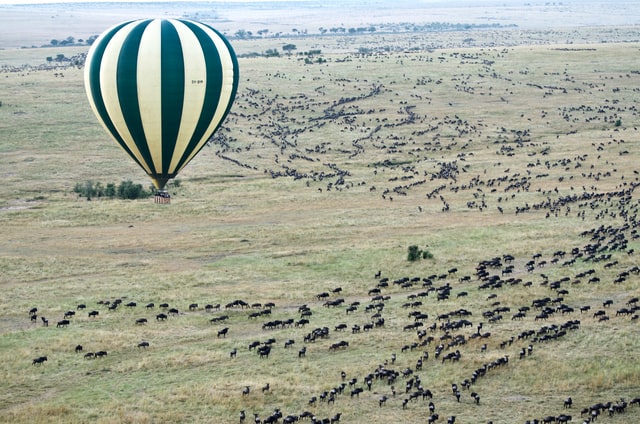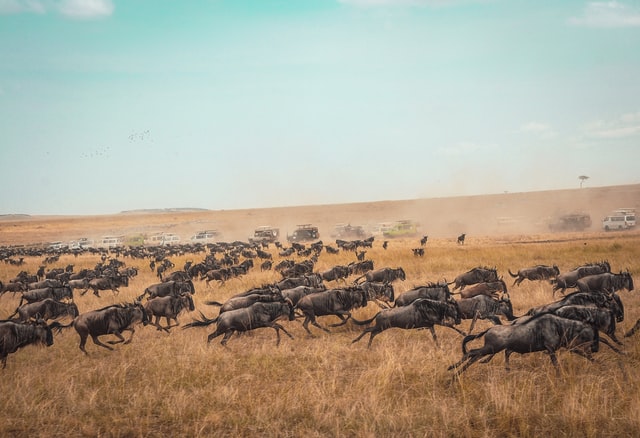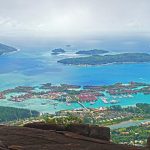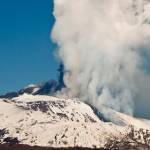A great culmination of wildlife behavior happens each year in East Africa, during the Great Wildebeest Migration in Kenya. Also known as the Gnu Migration, Serengeti Migration, and Maasai Mara Migration, this event is one of the last great mass movements of wildlife in the world. This process has happened for millions of years, so it’s about time you travel to witness it yourself.
The migration is as great of a spectacle as it is a paradox – while the timing is essential, we have no way of knowing when the herds will cross the river. Though we know rainfall catalyzes their movements, we don’t know when it will come. It’s difficult to predict the movement of animals when they are unsure of it themselves.
Travelers spend hours researching the timing of their visit, so they get the best viewing experience possible for this miraculous event. It takes a lot of work to put such a spectacular visit into motion, so we are here to help you enhance your safari trip to Kenya’s wilderness and learn more about the nature of the Wildebeest Migration.
Location
Because of the river crossings, Maasai Mara is the most popular place to witness migration. Maasai Mara is located in Southwestern Kenya, along the border of Tanzania. The region consists of two rivers and many grassy plains and hills.
Though some confuse the viewing of the Migration in Maasai Mara as the only time of migration, the wildebeests migrate throughout the entire year, moving continually with a herd. They move to find resources, most commonly, water and pasture for grazing. They constantly chase survival and fight the harsh conditions of migration.
The Wildebeests migrate in the “Serengeti ecosystem,” a 40,000 square mile area marked by Maasai Mara to the north and Tanzania’s Serengeti to the south, then circling in a clockwise direction.
Timing Your Trip and Weather Conditions

Seeing the migration in Maasai Mara is best from July to October, though it goes all year. You will witness more interactions between predators and prey and game viewing is at its peak. By August, the herds have crossed the Mara River and now charge through the northern region of Maasai Mara, and some remain in the Northern Serengeti.
The crossing of the Mara River is a challenging aspect of the migration – when the water levels are high, predators seek prey, and currents are active, many animals lose their lives. However, even during seasons where the currents are mild, predators lurk in and around the water.
By September or October, the migration starts to slow down as the migration goes East. Over a million wildebeests, in addition to thousands of zebras, elands, and gazelles move constantly while seeking pasture and water. When they cannot locate the resources they need in one area, they move again, seeking plentiful food sources, grasses, and water.
Due to the incomprehensible sizes of the herds, the Great Wildebeest Migration is a standout event where attendance is widely desired. The path of the animals and their methods for locating resources still maintains a mystery. Though, researchers develop understandings of how they behave as time goes on.
Many theorize that the path of migration correlates with weather patterns, with animals seeking the rainfall and following where the wet seasons occur. Due to the unpredictability of weather, the migration path appears more random than people would expect. Climate change has affected our ability to predict rainfall, as Tanzania and Kenya grow dryer and less predictable.
It may be hard to understand why the herds remain in one area for the time they do. All one can do is look at the patterns of previous years through historical data.
Viewing the Migration
As mentioned, the most popular tourist event during the migration is when the herds cross the Mara River. This typically occurs between July and August, then once again when the herd goes south in October and November. These months are the best time to view the migration in Maasai Mara.
Any migration viewing is a sight to be seen but the added element of the river crossing is a riveting and spectacular vision. You will be in awe. It is the subject of many documentaries, but nothing is like seeing the spectacle in real life.
Clusters of wildebeests gather around the river. Many visitors say they can sense the anticipation and hesitation to cross. They gather the courage to finally leave the edge of the river and run on the savannah. Your best option is to choose a mobile safari camp that moves along with the migration.
This accommodation ensures that you will bear witness to the movement. For a more exclusive experience, try a private conservancy rather than the Maasai Mara National Reserve.
When the day arrives, the crowds wait in silence. The wildebeests stand above the river, vying for a position that gives them a safe path along the water and opposite bank. They timidly watch the water for crocodiles with their eyes wide and their breath slow.
Visitors may wait hours and talk to their tour group and guide before anything happens. But finally, sometimes with no apparent catalyst, the animals rush the water with thousands of other animals trailing behind them. There are wildebeests, zebras, elands, and gazelles, all trying to survive.
The excitement of the viewing becomes anxiety when you notice crocodiles moving closer to the wildebeests. However, they are far from the only threat, considering the strength of the tides. The river often ends more animal lives than the predators do. It is difficult to watch the calves who are too tired to survive the bulk of the migration.
Despite the chaos, you watch the courageous animals reach the other bank one at a time, feeling a sense of joy and relief for the victors. Some fall victim to the predators that wait for an easy kill on the upper bank. Leopards, cheetahs, hyenas, and lions lurk for prey. For the animals that survive, reaching the greater plains of Maasai Mara, life gets easier for a while.
The water and pasture supply fade after a short while, and the herd must continue its journey, crossing the Mara River once again. The rains spread to other areas of the ecosystem, and animals continue their journey to find food and resources in the north and the east Serengeti between October and November.
Planning the Logistics of Your Trip

The number one advisory people give about viewing the Wildebeest Migration in Maasai Mara is to book as early as possible, at least a year in advance. This event is widely sought after by people around the world and from June to October, things get quite busy. The high season of the safari is when the popular river crossings occur, but you should remember that you may see herds any time of year.
If you want to learn about the many facets of migration, resources like African Meccas and Natural World Safaris help you locate lodging and strategic camps in Maasai Mara and Serengeti, getting the highest quality African plains tour experience.
Logistically speaking, we recommend you plan your trip at least a year in advance to ensure you get your preferred accommodations. The lodges and camps in Kenya and Tanzania are small and fill up quickly.
You must plan your timing accordingly. The migration is fluid and unpredictable, so you must know when to go on a safari to meet your expectations. Depending on what you want to witness, you should choose and arrange your trip methodically. Certain months have more activity than others.
Considering the movement of the animals, the time you visit could mean traveling to a different region, or even country. Try avoiding the crowds when you can for a more unique experience. The Maasai Mara National Reserve and Serengeti National Park get overloaded with visitors during the peak safari season.
Private conservancies are a wonderful option and offer some degree of exclusivity, accommodations, and impressive game viewing in private areas. They do not permit these activities for everyone. If you choose a conservancy, you open yourself up to night drives, bush walks, and off-road game viewing.
Make sure to diversity your Game Viewing. A Wildebeest Migration experience can get unpleasant due to the business, noise, and smells. We recommend that you find lodging or camping located far from the herds.
When you are on an involved vacation, it is important to arrange some tranquility and diverse activity. With such an intense vacation, balancing activity will only enhance your experience.
Final Notes
All in all, this event is incomparable. Those who witness the Wildebeest Migration say there is nothing on Earth like it, truly mesmerized by the vision. Watching this act of survival each year reminds viewers that parts of our world remain untouched, even amidst global disruptions. No matter what happens, the wildebeests will migrate once again, crossing the Mara River.
It takes some planning and coordination, but if you get the once in a lifetime chance to visit Maasai Mara and view the most spectacular leg of the migration, it may just change your life.


